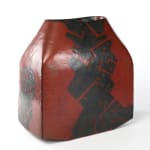Morino Taimei 森野泰明 b. 1934
33 x 31.2 x 19.1 cm
Further images
-
(View a larger image of thumbnail 1
)

-
(View a larger image of thumbnail 2
)

-
(View a larger image of thumbnail 3
)

-
(View a larger image of thumbnail 4
)

-
(View a larger image of thumbnail 5
)

-
(View a larger image of thumbnail 6
)

-
(View a larger image of thumbnail 7
)

-
(View a larger image of thumbnail 8
)

-
(View a larger image of thumbnail 9
)

-
(View a larger image of thumbnail 10
)

-
(View a larger image of thumbnail 11
)

-
(View a larger image of thumbnail 12
)

-
(View a larger image of thumbnail 13
)

-
(View a larger image of thumbnail 14
)

-
(View a larger image of thumbnail 15
)

-
(View a larger image of thumbnail 16
)

-
(View a larger image of thumbnail 17
)

Morino Taimei's work exemplifies the artist's ultimate pursuit of the Japanese concept of "ma" (間, Negative space). This concept simultaneously expresses the relational aspects of space, object, tempo, and rhythm. The asymmetrical nature of this vessel, oval-shaped with an off-center opening, imparts a sense of movement. This dynamism is further accentuated by the vessel's lightness and the elevation of the hidden foot, as well as the playful black patterns that dance across the rust-red, iron-glazed surface.
These patterns, partially inspired by Native American art that Morino encountered during his time teaching ceramics in the United States, possess a distinct kind of rhythm. The artist aspires for viewers to interpret the lines, shapes, and dots that playfully stretch across the surface much like one would read a piece of literature or poetry, ultimately enhancing their understanding of his work and its connection to "ma."
Morino's work remains firmly rooted in the traditions of his native Kyoto, yet his exposure to international art trends during the four years he spent teaching at the University of Chicago in the 1960s, along with his awareness of more avant-garde Japanese practices, have significantly influenced his art. This particular piece employs black and red glazes reminiscent of traditional ironworks on lacquer boxes and chests, effectively translating that tradition into a new medium. Morino's art continues to seamlessly blend tradition and innovation.
森野泰明は、日本の概念である「間」を究極まで追求した作品を作り、「間」とは、空間、物体、テンポ、リズムなどの関係性を同時に包み込むものです。開口部が中心から外れた楕円形のこの器の非対称性は、隠された足の軽さと持ち上げ、赤錆色の鉄釉の表面に踊る遊び心のある黒い模様によって強調される動きのある感覚を与えます。この模様は、森野氏がアメリカで陶芸を教えていた時に出会ったネイティブアメリカンのアートからヒントを得たもので、独特のリズムを持っています。鑑賞者が文学や詩を読むように、表面に戯れに伸びる線や形、点の間を読むことで、彼の作品と「間」との関係をより深く理解することができるだろうと森野氏は考えています。森野氏の作品は、京都の伝統にしっかりと根ざしていますが、1960年代にシカゴ大学で4年間教鞭をとっていたときに国際的な美術動向に触れ、日本の前衛的な手法を意識したことが作品に影響を与えています。この作品では、漆の箱や箪笥に施された伝統的な鉄の作品を思わせる黒と赤の釉薬を使い、その伝統を新たな媒体に置き換えています。森野氏の作品は、伝統と革新を融合させながら、「間」という複雑な概念へのこだわりを表現しています。
















